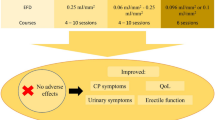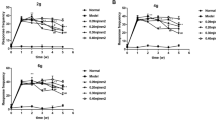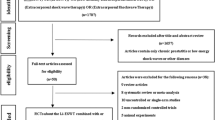Abstract
Resveratrol (Res) is a non-flavonoid polyphenol compound with biological pleiotropic properties, but low bioavailability limits its application value. Here, we synthesized a new Res derivative ((E)-5-(dimethylamino)-2-(4-methoxystyryl)phenol), and attempted to determine the function of Res derivative combined with radial extracorporeal shock wave therapy (rESWT) in chronic nonbacterial prostatitis (CNP). CNP model rats were constructed by subcutaneous administration of prostatein suspension (15 mg/ml), followed by rESWT treatment alone or in associated with Res or Res derivatives. In this study, inflammatory cell infiltration and tissue fibrosis in the prostate tissues of CNP rats were significantly deteriorated, which was effectively abolished by rESWT treatment alone or in combination with Res or Res derivative. The expression of interleukin 1β (IL-1β), tumor necrosis factor-α (TNF-α), nerve growth factor (NGF), and nuclear factor kappa-B (NF-κB) were increased, while silent information regulator 1 (SIRT1) expression was suppressed in the prostate tissues of CNP rats, which were then rescued by rESWT treatment alone or in associated with Res or Res derivative. Importantly, compared with Res derivative treatment alone or rESWT combined with Res treatment, combination treatment with rESWT and Res derivative was more effective in alleviating inflammation and fibrosis, in reducing IL-1β, TNF-α, NGF, and SIRT1 expression, and in facilitating SIRT1 expression. Overall, rESWT combined with Res derivative treatment improved CNP in rat by reducing inflammation and fibrosis, which attributed to regulate the expression of SIRT1 and NF-κB. Thus, this work provides a theoretical basis for rESWT combined with Res derivative in the clinical treatment of CNP.






Similar content being viewed by others
Data Availability
All data used or analyzed during this study are available from the corresponding author on reasonable request.
References
Ramakrishnan, K., and R. Salinas. 2010. Prostatitis: Acute and chronic. Primary Care 37: 547–63. https://doi.org/10.1016/j.pop.2010.04.007 (viii-ix).
Polackwich, A., and D. Shoskes. 2016. Chronic prostatitis/chronic pelvic pain syndrome: A review of evaluation and therapy. Prostate Cancer and Prostatic Diseases 19: 132–138. https://doi.org/10.1038/pcan.2016.8.
Murphy, S., A. Schaeffer, and P. Thumbikat. 2014. Immune mediators of chronic pelvic pain syndrome. Nature Reviews. Urology 11: 259–269. https://doi.org/10.1038/nrurol.2014.63.
Lien, C., C. Chung, C. Lin, and C. Chang. 2020. Increased risk of prostatitis in male patients with depression. The World Journal of Biological Psychiatry: The Official Journal of the World Federation of Societies of Biological Psychiatry 21: 111–118. https://doi.org/10.1080/15622975.2018.1533994.
Kataria, R., and A. Khatkar. 2019. Resveratrol in various pockets: A review. Current Topics in Medicinal Chemistry 19: 116–122. https://doi.org/10.2174/1568026619666190301173958.
Zhou, N., Y. Tian, H. Wu, Y. Cao, R. Li, and K. Zou. 2022. Protective effect of resveratrol on immortalized duck intestinal epithelial cells exposed to H(2)O(2). Molecules 27: 3542. https://doi.org/10.3390/molecules27113542.
Fiod Riccio, B., B. Fonseca-Santos, P. Colerato Ferrari, and M. Chorilli. 2020. Transcharacteristics, biological properties and analytical methods of -resveratrol: A review. Critical Reviews in Analytical Chemistry 50: 339–358. https://doi.org/10.1080/10408347.2019.1637242.
Singh, A., R. Singh, S. Verma, V. Rai, C. Kaschula, P. Maiti, and S. Gupta. 2019. Health benefits of resveratrol: Evidence from clinical studies. Medicinal Research Reviews 39: 1851–1891. https://doi.org/10.1002/med.21565.
Breuss, J., A. Atanasov, and P. Uhrin. 2019. Resveratrol and its effects on the vascular system. International Journal of Molecular Sciences 20: 1523. https://doi.org/10.3390/ijms20071523.
Yousef, M., I. Vlachogiannis, and E. Tsiani. 2017. Effects of resveratrol against lung cancer: In vitro and in vivo studies. Nutrients 9: 1231. https://doi.org/10.3390/nu9111231.
Yang, Q., Y. He, X. Zhong, W. Xie, and J. Zhou. 2019. Resveratrol ameliorates gouty inflammation via upregulation of sirtuin 1 to promote autophagy in gout patients. Inflammopharmacology 27: 47–56. https://doi.org/10.1007/s10787-018-00555-4.
Ma, C., Y. Wang, L. Dong, M. Li, and W. Cai. 2015. Anti-inflammatory effect of resveratrol through the suppression of NF-κB and JAK/STAT signaling pathways. Acta Biochimica et Biophysica Sinica 47: 207–213. https://doi.org/10.1093/abbs/gmu135.
Vicari, E., A. Arancio, V. Catania, B. Vicari, G. Sidoti, R. Castiglione, and M. Malaguarnera. 2020. Resveratrol reduces inflammation-related prostate fibrosis. International Journal of Medical Sciences 17: 1864–1870. https://doi.org/10.7150/ijms.44443.
Yu, Y., J. Jiang, Y. He, W. Wang, C. Shen, and B. Yang. 2017. Resveratrol improves urinary dysfunction in rats with chronic prostatitis and suppresses the activity of the stem cell factor/c-Kit signaling pathway. Molecular Medicine Reports 16: 1395–1400. https://doi.org/10.3892/mmr.2017.6721.
Walle, T. 2011. Bioavailability of resveratrol. Annals of the New York Academy of Sciences 1215: 9–15. https://doi.org/10.1111/j.1749-6632.2010.05842.x.
Milton-Laskíbar, I., S. Gómez-Zorita, N. Arias, N. Romo-Miguel, M. González, A. Fernández-Quintela, and M. Portillo. 2020. Effects of resveratrol and its derivative pterostilbene on brown adipose tissue thermogenic activation and on white adipose tissue browning process. Journal of Physiology and Biochemistry 76: 269–278. https://doi.org/10.1007/s13105-020-00735-3.
Ben Khalifa, B., S. Naouar, W. Gazzah, B. Salem, and R. El Kamel. 2016. Predictive factors of extracorporeal shock wave lithotripsy success for urinary stones. La Tunisie Medicale 94: 397–400.
Guo, P., F. Gao, T. Zhao, W. Sun, B. Wang, and Z. Li. 2017. Positive effects of extracorporeal shock wave therapy on spasticity in poststroke patients: A meta-analysis. Journal of Stroke and Cerebrovascular Diseases: The Official Journal of National Stroke Association 26: 2470–2476. https://doi.org/10.1016/j.jstrokecerebrovasdis.2017.08.019.
Yuan, P., D. Ma, Y. Zhang, X. Gao, Z. Liu, R. Li, T. Wang, S. Wang, J. Liu, and X. Liu. 2019. Efficacy of low-intensity extracorporeal shock wave therapy for the treatment of chronic prostatitis/chronic pelvic pain syndrome: A systematic review and meta-analysis. Neurourology and Urodynamics 38: 1457–1466. https://doi.org/10.1002/nau.24017.
Bernoulli, J., E. Yatkin, Y. Konkol, E.M. Talvitie, R. Santti, and T. Streng. 2008. Prostatic inflammation and obstructive voiding in the adult Noble rat: Impact of the testosterone to estradiol ratio in serum. Prostate 68: 1296–1306. https://doi.org/10.1002/pros.20791.
Hou, C., L. Lu, Z. Liu, Y. Lian, and J. Xiao. 2021. Resveratrol reduces drug resistance of SCLC cells by suppressing the inflammatory microenvironment and the STAT3/VEGF pathway. FEBS Open Bio 11: 2256–2265. https://doi.org/10.1002/2211-5463.13230.
Luo, Y., X. Yu, P. Zhao, J. Huang, and X. Huang. 2022. Effects of resveratrol on tight junction proteins and the Notch1 pathway in an HT-29 cell model of inflammation induced by lipopolysaccharide. Inflammation. https://doi.org/10.1007/s10753-022-01704-2.
Zeng, H., Y. He, Y. Yu, J. Zhang, X. Zeng, F. Gong, Q. Liu, and B. Yang. 2018. Resveratrol improves prostate fibrosis during progression of urinary dysfunction in chronic prostatitis by mast cell suppression. Molecular Medicine Reports 17: 918–924. https://doi.org/10.3892/mmr.2017.7960.
He, Y., H. Zeng, Y. Yu, J. Zhang, X. Duan, X. Zeng, F. Gong, Q. Liu, and B. Yang. 2017. Resveratrol improves prostate fibrosis during progression of urinary dysfunction in chronic prostatitis. Environmental Toxicology and Pharmacology 54: 120–124. https://doi.org/10.1016/j.etap.2017.06.025.
Qian, X., Z. Gu, W, Guan, J. Qi. 2021. Resveratrol could attenuate prostatic inflammation in rats with oestradiol-induced chronic prostatitis. 53:e14004. https://doi.org/10.1111/and.14004.
Igarashi, T., P. Tyagi, and S. Mizoguchi. 2021. Therapeutic effects of nerve growth factor-targeting therapy on bladder overactivity in rats with prostatic inflammation. Prostate 81: 1303–1309. https://doi.org/10.1002/pros.24227.
Jurczyk, M., and J. Kasperczyk. 2022. Nanoparticles loaded with docetaxel and resveratrol as an advanced tool for cancer therapy. Biomedicines 10: 1187. https://doi.org/10.3390/biomedicines10051187.
Weiskirchen, S., and R. Weiskirchen. 2016. Resveratrol: how much wine do you have to drink to stay healthy? Advances in Nutrition (Bethesda, Md.) 7: 706–18. https://doi.org/10.3945/an.115.011627.
Smoliga, J., and O. Blanchard. 2014. Enhancing the delivery of resveratrol in humans: If low bioavailability is the problem, what is the solution? Molecules (Basel, Switzerland) 19: 17154–17172. https://doi.org/10.3390/molecules191117154.
Delmas, D., V. Aires, E. Limagne, P. Dutartre, F. Mazué, F. Ghiringhelli, and N. Latruffe. 2011. Transport, stability, and biological activity of resveratrol. Annals of the New York Academy of Sciences 1215: 48–59. https://doi.org/10.1111/j.1749-6632.2010.05871.x.
Liao, C., G. Xie, J. Tsauo, H. Chen, and T. Liou. 2018. Efficacy of extracorporeal shock wave therapy for knee tendinopathies and other soft tissue disorders: A meta-analysis of randomized controlled trials. BMC Musculoskeletal Disorders 19: 278. https://doi.org/10.1186/s12891-018-2204-6.
Shen, P., M. Jiang, J. Yang, X. Li, Y. Li, W. Wei, Y. Dai, H. Zeng, and J. Wang. 2011. Use of ureteral stent in extracorporeal shock wave lithotripsy for upper urinary calculi: A systematic review and meta-analysis. The Journal of Urology 186: 1328–1335. https://doi.org/10.1016/j.juro.2011.05.073.
Feng, B., Z. Dong, Y. Wang, G. Yan, E. Yang, H. Cheng, C. Liang, Z. Hao, X. Zhang, Z. Song, Z. Jiang, M. Chen, Z. Yue, and Z. Wang. 2021. Li-ESWT treatment reduces inflammation, oxidative stress, and pain via the PI3K/AKT/FOXO1 pathway in autoimmune prostatitis rat models. Andrology 9: 1593–1602. https://doi.org/10.1111/andr.13027.
Jeon, S., G. Zhu, E. Kwon, K. Lee, H. Cho, U. Ha, S. Hong, J. Lee, W. Bae, and S. Kim. 2019. Extracorporeal shock wave therapy decreases COX-2 by inhibiting TLR4-NFκB pathway in a prostatitis rat model. The Prostate 79: 1498–1504. https://doi.org/10.1002/pros.23880.
Birowo, P., E. Rangganata, N. Rasyid, and W. Atmoko. 2020. Efficacy and safety of extracorporeal shockwave therapy for the treatment of chronic non-bacterial prostatitis: A systematic review and meta-analysis. PLoS ONE 15: e0244295. https://doi.org/10.1371/journal.pone.0244295.
Wang, H.J., P. Tyagi, and Y.M. Chen. 2019. Low energy shock wave therapy inhibits inflammatory molecules and suppresses prostatic pain and hypersensitivity in a capsaicin induced prostatitis model in rats. International Journal of Molecular Science 20: 4777. https://doi.org/10.3390/ijms20194777.
Author information
Authors and Affiliations
Contributions
Zhengyao Song designed and performed the research, and wrote the manuscript; Chen Jin and Zichen Bian had done the experiment and analyzed data; Chaozhao Liang supervised the entire study and reviewed the manuscript. All authors read and approved the final manuscript.
Corresponding author
Ethics declarations
Ethics Approval and Consent to Participate
All programs were carried out under the authorization of the Ethics Committee of the First Affiliated Hospital of Anhui Medical University.
Consent for Publication
Not applicable.
Competing Interests
The authors declare no competing interests.
Additional information
Publisher's Note
Springer Nature remains neutral with regard to jurisdictional claims in published maps and institutional affiliations.
Supplementary Information
Below is the link to the electronic supplementary material.
Rights and permissions
Springer Nature or its licensor (e.g. a society or other partner) holds exclusive rights to this article under a publishing agreement with the author(s) or other rightsholder(s); author self-archiving of the accepted manuscript version of this article is solely governed by the terms of such publishing agreement and applicable law.
About this article
Cite this article
Song, Z., Jin, C., Bian, Z. et al. Radial Extracorporeal Shock Wave Therapy Combined with Resveratrol Derivative Alleviates Chronic Nonbacterial Prostatitis in Rats. Inflammation 46, 584–597 (2023). https://doi.org/10.1007/s10753-022-01757-3
Received:
Revised:
Accepted:
Published:
Issue Date:
DOI: https://doi.org/10.1007/s10753-022-01757-3




